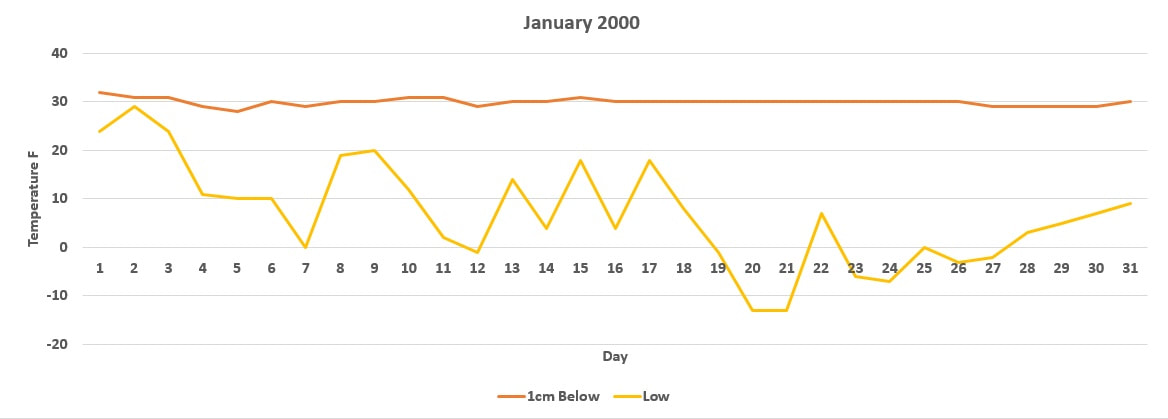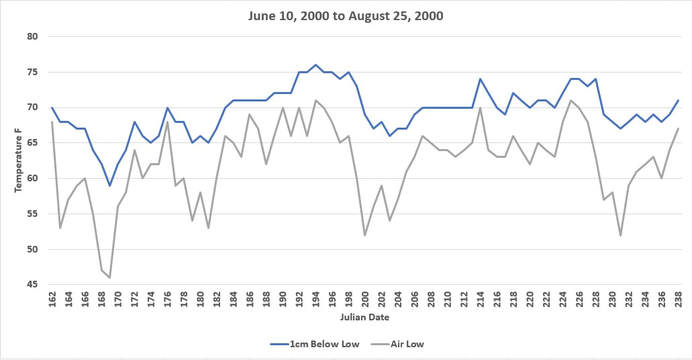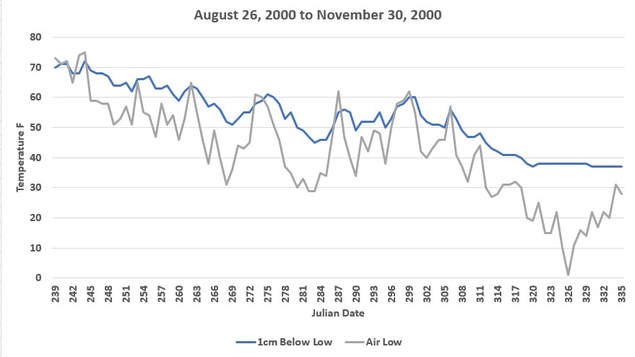Underground to Surface Temperature Comparisons
Many argue that our atmosphere is the driving mechanism behind Climate Change, while others dispute this. In order to confirm or refute this claim, the year 2000 was selected for analysis. Temperatures are observed and recorded five feet off the ground along with specific requirements. Although the atmosphere is clearly warming the thermometer, the directional flow is in question and this can be determined through temperature differentiation. Inversions heighten during the night and will rapidly dissipate during the day when the sun rises, so using the low temperatures recorded both above and 1cm below ground would demonstrate the greatest effect supporting any atmospheric warming impact upon the thermometer. Using the known surface temperatures from the Minneapolis International Airport, and the underground data from the University of Minnesota St. Paul Campus Climate Observatory, each month was graphed out.
Winter Months
During the winter months, when the frost sets in, the atmosphere controls surface temperatures. Even when the temperatures drop well below 0F, the soil 1cm beneath the ground maintains an average of 30F. In December, we can see the frost setting in on December 5, 2000. In the end of February a ground inversion occurred and is part of the spring cycle when a warm air mass builds and moves into the region from ground heat. Generally, these are generated in southern locations where heat builds, expands, and swells the atmosphere, and then the trade-winds move this heat across the land. This is part of the normal cycle that is vital for the removal of ground frost every spring. During this period of time the atmosphere controls surface temperatures and is responsible for cooling the earth.
Spring, Summer and Fall
From March through November, a total of 275 days, only 23 nights did the atmospheric temperatures rise to a level greater than the temperature 1cm below the surface soil. Eleven of these days occurred in March, April, May and the first week of June, and twelve in August through November, primarily during the seasonal changes. This indicates that 92% of the time during these months in 2000, heat is rising from the ground warming our world. The atmosphere is unable to maintain enough energy when the night time hours exceed the day time hours resulting in a slow discharge of energy being released out of the soils and winter sets in. When the daytime hours exceed the night time hours, the atmosphere maintains more energy and expands allowing for spring to begin and energy begins to build in the subterranean regions of the continental plates.

Further research was then applied to the Swan Lake Research Farm located near Morris, MN. Temperatures are taken both above and 2" below ground. March 1 through November 30 was analyzed from 1989 to 2017, 4,950 nights. The temperatures above ground were warmer than the region 2" below ground on 477 nights, a total of 9.63%. Never has this occurred in the month of August and only 1% of the time in July and September. April of 2001 was the month with the greatest level of night time ground inversions when 2/3 of the month, 20 days, the air was warmer than the ground.
During these months, water vapor is both a warming and cooling mechanism, with it's cooling generating a far greater effect than it's ability to warm. When these graphs dip in both surface and subterranean temperatures, precipitation is frequently associated with the event. These events clearly result in surface cooling affecting both day and night time temperatures.
Based upon the known laws and common understanding, it is not possible for one environment, such as the atmosphere, to heat another to a temperature greater than itself. This alone excludes the atmosphere as the primary driver for our worlds heat that we feel on the surface and isolates research to the rising ground temperatures.





